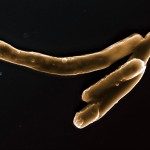Link to Pubmed [PMID] – 21030587
J. Biol. Chem. 2010 Dec;285(53):41348-55
The arabinogalactan (AG) of slow growing pathogenic Mycobacterium spp. is characterized by the presence of galactosamine (GalN) modifying some of the interior branched arabinosyl residues. The biosynthetic origin of this substituent and its role(s) in the physiology and/or pathogenicity of mycobacteria are not known. We report on the discovery of a polyprenyl-phospho-N-acetylgalactosaminyl synthase (PpgS) and the glycosyltransferase Rv3779 from Mycobacterium tuberculosis required, respectively, for providing and transferring the GalN substrate for the modification of AG. Disruption of either ppgS (Rv3631) or Rv3779 totally abolished the synthesis of the GalN substituent of AG in M. tuberculosis H37Rv. Conversely, expression of ppgS in Mycobacterium smegmatis conferred upon this species otherwise devoid of ppgS ortholog and any detectable polyprenyl-phospho-N-acetylgalactosaminyl synthase activity the ability to synthesize polyprenyl-phospho-N-acetylgalactosamine (polyprenyl-P-GalNAc) from polyprenyl-P and UDP-GalNAc. Interestingly, this catalytic activity was increased 40-50-fold by co-expressing Rv3632, the encoding gene of a small membrane protein apparently co-transcribed with ppgS in M. tuberculosis H37Rv. The discovery of this novel lipid-linked sugar donor and the involvement of a the glycosyltransferase C-type glycosyltransferase in its transfer onto its final acceptor suggest that pathogenic mycobacteria modify AG on the periplasmic side of the plasma membrane. The availability of a ppgS knock-out mutant of M. tuberculosis provides unique opportunities to investigate the physiological function of the GalN substituent and the potential impact it may have on host-pathogen interactions.

